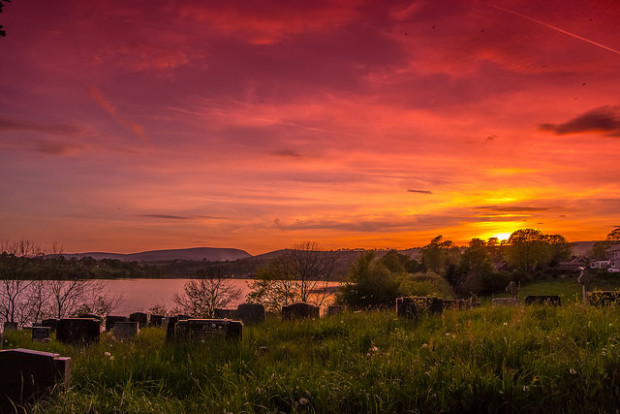You have no items in your cart. Want to get some nice things?
Go shopping
The cradle rocks above an abyss, and common sense tells us that our existence is but a brief crack of light between two eternities of darkness. Although the two are identical twins, man, as a rule, views the prenatal abyss with more calm than the one he is heading for (at some forty-five hundred heartbeats an hour).
Vladimir Nabokov, Speak, Memory.
When I was 23, I moved into a funeral home. My relationship had just ended and some kind friends, who ran a suburban funeral parlour, offered me their spare room. They lived in the basement, looking out into the car park where mourners snuck cigarettes, the men in suits and women in rickety heels. Upstairs, the funeral home had an atmosphere similar to a mid-range hotel, the same unencouraging grey carpets and pervasive odour of cleaning products. The only obvious difference was a slight undercurrent of flowers and, of course, the dead.
My friend, the funeral director, was a conscientious man with a black sense of humour. At night he fished abandoned Coke cans from unlikely places and hauled elaborate floral displays off to the dumpster. I occasionally lent a hand, disposing of wilted lilies pinned to crucifixes at enormous expense. His job, unsurprisingly, bred a prosaic attitude towards death. There were mortuary textbooks on the dinner table and a jar of pink reconstructive putty collecting dust on the bookshelf. Most mealtime conversations revolved around his clients, the bereaved; the arguments, breakdowns, the man leaning over his wife in the coffin and wistfully remarking: “Well, at least her tits still look great.”
Open caskets are still far more popular in Canada than the UK, one of those mysterious cultural divisions that emerge over time. Because this was a Canadian funeral home, embalmed cadavers were left in caskets overnight to prepare for early morning viewings. It takes surprisingly little to get used to the dead. The process of mortuary care sanitizes corpses, masking their humanity with industrial quantities of makeup. Any recognition that they had once been a person was usually down to the failure of the mortician; the cracks in heavy makeup around the knuckles; a few stray hairs across a woman’s cheek. I remember my friend gently rearranging the body of a man that had shifted during the night. As he lifted the bottom of the coffin, I was surprised to see the man’s sockless feet, white and swollen with oedema. The pathos of that residual humanity was much greater to me, a stranger, than the carefully blank face.
There was always something unsettling about the stillness of the bodies. “At rest” turns out to be a disturbing state for the observer if not, presumably, for the corpse. What was disconcerting was not that the bodies were somehow obtrusive but rather the opposite. Without any personal connection to the dead, cadavers all too easily became just another object in the room. The starkness of death was that transformation from person to passive article, devoid of opinion, and disregarded as easily as a lamp or a chair.
*
He is happy enough, that lives to die well.
-Joseph Hall, Three Centuries of Meditations and Vowes
In among the Diagnostic and Statistical Manual of Mental Disorder’s wonderful list of phobias is thanatophobia, the abnormal fear of death. This, of course, begs the question, what a normal fear of death might be? One of the more pat modern responses to mortality is: why do you care? You’ll be dead, you won’t know. Which misses the point that fear of extinction is less about the experience of nothingness than its inevitability. Existential dread may be cowardly but it’s deeply human, given that our lives are shaped by their brevity. Because living in the funeral home made death more visible, it also removed a level of abstraction from the dead. It was this level of normalcy that made mortality less frightening.
Mortuary workers are some of the very few people who regularly encounter death in its neutral form, separate from personal grief or prurient interest. Rapidly declining childhood and maternal mortality, following on the heels of developments in medicine and sanitation, have helped banish physical decay to the peripheries of our culture. In the 17th century, the satirist and Bishop of Exeter Joseph Hall could truthfully write: “Death borders upon our birth. And our cradle stands in the grave.” This is evidently no longer the case in the wealthy developed world.
But while the dead are less visible in public spaces, our interest in death has not dissipated. We may no longer advertise our bereavement like the Victorians by dressing in black crepe and wearing jewellery of calcified coal but we have Facebook memorial pages, execution videos and a 24-hour news cycle of repetitive tragedy. It could be argued that murder mysteries, CSI and Scandi noir, are the memento moris of the 21st century; comfortable, middle-class people entertained by serial killers, necrophiliacs and dead children. Whatever else these stories may be, they are also an inducement to think about death.
But murder mysteries tell us little about how to manage our own mortality. The memento mori had meaning because it existed inside an already coherent system. Paintings of skulls and rotten fruit prompted their audience to consider the importance of salvation rather than ruminate on the expiry date of plums. There is for many of us, myself included, no longer any equivalent cultural system from which to draw meaning about death. The decline of religious observance in many Western countries has encouraged a new strain of humanist morality. But a secular consideration of death has not emerged alongside this newly defined moral coda.
This is perhaps because humanism, with its movement away from God and the afterlife, has little to offer other than stoicism. In “Unweaving the Rainbow”, Richard Dawkins writes:
We are going to die, and that makes us the lucky ones. Most people are never going to die because they are never going to be born… We privileged few, who won the lottery of birth against all odds, how dare we whine at our inevitable return to that prior state from which the vast majority have never stirred?
While Dawkins is clearly not a man to mince his words, this is not an uncommon sentiment. Death is unavoidable and life precious so why be afraid?
It’s unrealistic to imagine our need to contend with death has vanished over time. Our culture is studded with reminders that we will die. Death may be an addendum, but it remains a defining one in lives bracketed by absence. What makes Dawkins’ argument difficult is less its content than its inflexibility. Mortality is bound up with uncertainty, and any useful consideration of death is likely to be a process rather than anything conclusive.
One of many irreligious people, I hope for a better secular response to mortality. My time in the funeral home suggested that reviving mortuary customs may be part of the answer. Laying out the dead and washing bodies are reminders that death is just another human state. The same is true of commemorative rites, whether it be eating with the dead in Russia or the pebbles traditionally laid on the tops of Jewish gravestones. Regardless of what follows next, mortality becomes easier when death is not entirely a stranger.

About Dylan Brethour
Dylan is a Canadian freelance writer living in London. She previously worked in Beijing where she enjoyed post-revolutionary poetry and watching dating shows. Dylan is currently writing her first novel while testing the long-term effects of caffeine abuse on the human body. She tweets at @DylanBrethour.




